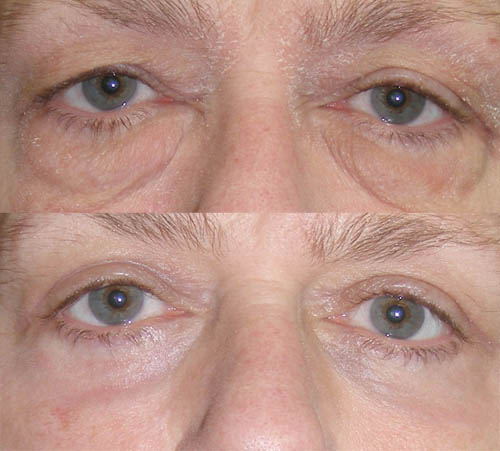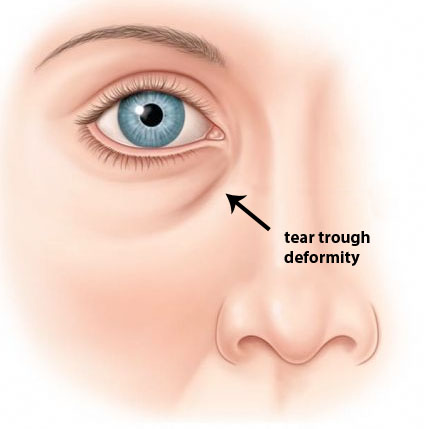When looking at other people’s faces, the first thing our eyes are drawn to are their eyes. The eyes and the skin around them can tell us a lot about a person, or so we think. When we see dark circles or bags under the eyes we may assume the person is tired or possibly ill. This has led people with this problem to search out all sorts of remedies to improve their appearance. Dark circles under eyes affect both men and women, usually starting in adulthood, although children can develop dark circles under their eyes as well. A common reason for dark circles is fatigue, but they may still form in a well rested person. Sometimes, what appear to be under-eye circles are just shadows cast by puffy eyelids or hollows under your eyes that develop as a normal part of aging. First, we need to understand the causes of bags and circles, then we can try to eliminate them.
The Mayo Clinic lists the following as causes of dark circles:
- Allergies
- Atopic dermatitis (eczema)
- Heredity — dark under-eye circles can run in families
- Lifestyle factors, such as physical or emotional stress, smoking, or chronic alcohol use can take a toll on your appearance
- Nasal congestion (which can dilate and darken the veins that drain from your eyes to your nose)
- Pigmentation irregularities — these are a particular concern for people of color, especially blacks and Asians
- Rubbing or scratching your eyes (see allergies)
- Sun exposure, which prompts your body to produce more melanin, the pigment that gives skin its color
- Thinning skin and loss of fat and collagen — common as you age — can make the reddish-blue blood vessels under your eyes more obvious
Now that we know what causes these changes, what can be done about them? First, to be sure you have dark circles, look in the mirror and pull down on the skin of the lower eyelid. You truly have dark circles, not bags, if the circle still remains when the skin is tight. For mild to moderate dark circles due to discoloration of the skin, there are some simple and inexpensive treatments that may work
- Bring in the cold- Try two chilled teaspoons, an ice pack or a bag of frozen peas wrapped in a soft cloth to temporarily reduce dilated and discolored under-eye blood vessels. Cooled cucumbers or used teabag have also been recommended, just remember it is the cold that helps, not the tea or some aspect of the vegetable.
- Elevate your head – use two or more pillows to prevent puffiness that develops when fluid pools in your lower eyelids.
- Protect yourself from the sun – Although a tan might hide dark circles in the short term, in the long run, the extra pigment it produces can make circles worse. Use a daily sunscreen and wear sunglasses.
- Treat allergies and sinus problems. Use a daily allergy medication, such as Allegra or Zyrtec, if seasonal allergies are a problem. Rinsing your sinuses with a saltwater solution (mix 1/4 teaspoon sea salt with 2 cups warm water) or over-the-counter saline spray can help relieve nasal congestion.
- Get your beauty rest – lack of sleep makes you paler and more hollow-eyed, so shadows and circles you already have are more obvious.
- Find a good eye cream – There are hundreds of skin creams that claim to reduce or prevent under-eye circles, but you should shop wisely. The results of one study in the Journal of Cosmetic Dermatology showed that cream, among other things, the Brazilian suma plant, significantly improved the appearance of dark circles under the eyes
- When all else fails, cover up – Find the right colored concealer to hide dark circles. For example, if the circles under your eyes are bluish, use a peach-colored concealer, not one that’s white or gray. Make sure the product is safe for use around the eyes. Stop using it if you get any eye irritation
When these fail, consider speaking with a dermatologist, who could recommend various skin treatments with chemicals such as hydroquinone or kojic acid, which can lighten the skin. Also, many laser treatments have been successful in lightening the skin, but again, these should only be performed by a dermatologist experienced in use of lasers around the eye.
If you truly have bags under the eyes, no amount of eye cream of concealer will eliminate these changes, and lasers are usually only effective for the most minor of changes. You now need to consider a cosmetic procedure to get the most benefit.
- Blepharoplasty is a procedure that involves removing the redundant fat beneath the eye (and above when necessary) as well as removing some excess skin in certain individuals. This leads to a more natural transition from the cheek to the eyelid and a younger appearance. Consider this middle aged patient before and after upper and lower lid blepharoplasty. A small change to her lower lids makes a dramatic difference.

- Injectable fillers: The tear trough deformity shown above can now be treated with fillers, such as Juvederm, which can soften or eliminate its appearance for 12 months or more.
If you are fed up with those baggy lower lids and no amount of home remedies have helped, contact us for a consultation and we can discuss your options.

